Sunday, June 26, 2005
Making Connections
So called "science fiction" is speculative or extrapolative literature (or sometimes visual art or music) dealing in some way with the idea of change - most often changing human responses to the altered, or shifting of some alternative reality, most often, simply, "future fiction."
In Earth Abides the protagonist is "dealing" with the changes in his world and learning to respond to a "shifting" reality. Stewart's "future fiction" follows a common theme in post-apocalyptic novels, one of renewal and survival. In order to survive, and inevitably for a renewal to occur, "human responses" are altered. This battle for survival and renewal is a theme often used is used by SF writers.

.jpg) It is a theme Stephen King uses in his best selling novel, The Stand where the survivors are preparing for the ultimate battle between good and evil. King has stated that Earth Abides was the inspiration for his popular novel. In King's, On Writing, he acknowledges the influence science fiction has had on his writing and humorously points out why he enjoyed reading and watching SF:
It is a theme Stephen King uses in his best selling novel, The Stand where the survivors are preparing for the ultimate battle between good and evil. King has stated that Earth Abides was the inspiration for his popular novel. In King's, On Writing, he acknowledges the influence science fiction has had on his writing and humorously points out why he enjoyed reading and watching SF:[King] was a child who dug Yvette Vickers from Attack of the Giant Leeches, not Sandra Dee. "I wanted monsters that ate whole cities, radioactive corpses that came out of the ocean and ate surfers, and girls in black bras who looked like trailer trash."(Stephen King, On Writing, 2000)


Just as King was influenced by Stewart, some critics feel Stewart was influenced by Jack London, who in turn may have been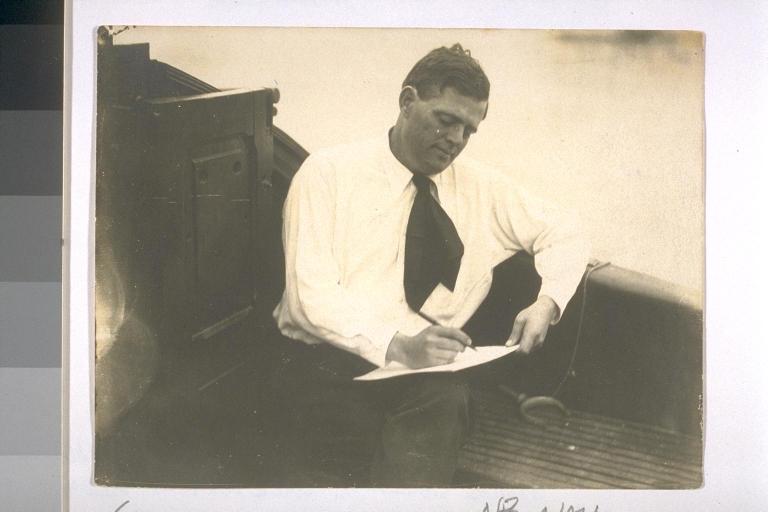 influenced by the last surviving Yahi tribe member, Ishi. In David Pringle's, Apologies to Ishi, he calls London "the father of California sf." In June, 1912, one year after the "discovery" of Ishi, London's novella, The Scarlet Plague, was published in England by the London Magazine. London's story tells the tale of an old man in 21st century San Francisco (the year 2073) trying to explain "the days of automobiles and airplanes" to his "tribal" grandchildren who are living off the land of a now forested California (sound familiar class?).
influenced by the last surviving Yahi tribe member, Ishi. In David Pringle's, Apologies to Ishi, he calls London "the father of California sf." In June, 1912, one year after the "discovery" of Ishi, London's novella, The Scarlet Plague, was published in England by the London Magazine. London's story tells the tale of an old man in 21st century San Francisco (the year 2073) trying to explain "the days of automobiles and airplanes" to his "tribal" grandchildren who are living off the land of a now forested California (sound familiar class?).
The de-evolution of society, following a catastrophic event, provides much fodder for the sf writer and gives readers plenty to think about. Hmmm . . .what if ?

"I do not know with what weapons World War III will be fought, but World War IV will be fought with sticks and stones." Albert Einstein
Writing in 1940's
As the Cold War begins many people become concerned about the "what if." What would happen if there was a nuclear war? How would humankind survive? Would it lead to an apocalypse? Stewart took these concerns and responded to them in Earth Abides. In his novel Stewart shows his readers that survival is possible.
 John Clute and Peter Nicholls, authors of The Encyclopedia of Science Fiction, feel the desire to prove one can survive is one of the reasons post-apocalytic stories are popular:
John Clute and Peter Nicholls, authors of The Encyclopedia of Science Fiction, feel the desire to prove one can survive is one of the reasons post-apocalytic stories are popular:John Clute and Peter Nicholls feel that post-apocalyptic or disaster stories are so popular because they appeal to secret desires we all share: a depopulated world, escape from the constraints of a highly organized industrial society, and the opportunity to prove one's ability to survive.
D. D. Shade (1998)
Even though Earth Abides was written in 1949 it is still popular today. Berkeley has included it in its summer reading list for students. It has been published in 27 languages and has received much praise:
If I should be naming five novels out of the last ten years most worthwhile, most worth reading, I would certainly include a book titled, Earth Abides. It reads as a good story and has profound meanings. I thank Brother Stewart for writing it. (Carl Sandburg, 1950's)
The novel is written with great conviction and emotional intensity. It moved me to tears when I first read it.(David Pringle, Science Fiction: The 100 Best Novels)
Stewart's optimistic vision of 1949 is one that is still appreciated today.George Rippey Stewart (1895-1980)
Stewart had a keen interest in US history, name places, and ecology. In 1951 he became the founding member of the American Name Society. Stewart believed American toppnymists put a greater emphasis to "the motivation of the namer" and to "the human activity of naming." This belief is evident in Earth Abides when Ish and Em decide to name each year after an activity or event from that year (Year of the Baby, Year of the Fires, etc.). The naming of the year, and the chiseling of the number into stone, became a tradition and ritual for Ish and the tribe. The naming of each year became important to the tribe, just as the names of places were important to Stewart.
It is Stewart's keen interest and knowledge of names that leads one to examine his choice of name for his protagonist in Earth Abides. Georges T. Dodds, in a 2000 review of Earth Abides, draws a comparison between Ish and Ishi, the last of the Yahi tribe "discovered" by Dr. Alfred Louis
 Kroeber* and his associates at The University of California in Berkeley. Stewart, who received his MA from there and also returned to teach English at Berkeley in 1922, would have known the story of Ishi.
Kroeber* and his associates at The University of California in Berkeley. Stewart, who received his MA from there and also returned to teach English at Berkeley in 1922, would have known the story of Ishi.First of all, Ishi simply means "a man." In Earth Abides, Ish is representative of [hu]mankind. Both Ishi and Ish emerge from the mountains or woods, hence the name Isherwood. Ishi enters a new world of industry and science, while in contrast, Ish enters a world where industry and science are things of the past. Interestingly, both men have difficulty coming to terms with their new worlds and being the centre of attention. Both men are curiosities to the people they encounter as Ishi is the last of his tribe and Ish is "the last American." It is interesting to note another parallel Stewart draws, both men teach those around them how to make a bow and arrow. Stewart's comparison may be lost on some of his readers but to those in the know it is a clear message that "man" can survive.
Just as this comparison may not be as well know to some, George R. Stewart himself is relatively unknown to most readers. It is his influences influences and accomplishments that are more well known. His 1941 novel, Storm, featuring a Pacific storm called "Maria" as the protagonist, inspired the National Weather Service to use personal names to designate storms. This same book was made into a Disney movie, and became the inspiration for the song, "They Call The Wind Maria" for the sound track of the movie, "Paint Your Wagon."
Though not among the list of top authors in popular culture, Stewart is much respected by his peers. His friend, Wallace Stegner descripes Stewart as a "poet and precisionist." In Donald M. Scott's 1996 biography on he explains how Stewart loved travelling by "foot or road" and how he had "spent a lifetime, wandering and wondering." It is Stewart's "wonder" that created his only science fiction work, Earth Abides. It is through his work that he has been able to accomplish what his protagonist Ish was unable to do, pass on his knowledge to a new generation.
-------------------------------------------------------------------------------------
*Interesting tid bit, this is Ursula K. Le Guin's father!
Cover evolution
 l the artwork found on a novel cover speaks volumes. It often reflects w
l the artwork found on a novel cover speaks volumes. It often reflects w hat is popular or accepted by its targeted audience. On one of the earlier covers, created by Robert Abbett for ACE Paperbacks, the art work is a depiction of Ish and Em. In the painting, Ish resembles a movie action hero and Em looks like a 50's suburban housewife dressed for a dinner party. The body positioning on the cover is interesting as well. Ish is clearly depicted as the leader and Em as a follower that needs to hold on to him for support. An alternative cover had been created by the artist which depicted Em in front of Ish, although at a lower level than him, dressed in a low-cut, form-fitting dress which created a much more sexual image of Em. The final cover used ignores Em's race and sexuality and places her in a subordinate position, an image of woman that was marketable at the time.
hat is popular or accepted by its targeted audience. On one of the earlier covers, created by Robert Abbett for ACE Paperbacks, the art work is a depiction of Ish and Em. In the painting, Ish resembles a movie action hero and Em looks like a 50's suburban housewife dressed for a dinner party. The body positioning on the cover is interesting as well. Ish is clearly depicted as the leader and Em as a follower that needs to hold on to him for support. An alternative cover had been created by the artist which depicted Em in front of Ish, although at a lower level than him, dressed in a low-cut, form-fitting dress which created a much more sexual image of Em. The final cover used ignores Em's race and sexuality and places her in a subordinate position, an image of woman that was marketable at the time. The original book cover art did not focus on the characters. The dustjacket cover from 1949 sho ws a city that is bleak and dark.
ws a city that is bleak and dark. 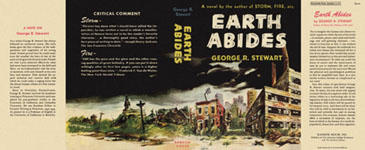
It is interesting to note the original book cover has no indication of human survival even though the book is very much about how humankind can survive.
The art on a 1971 Fawcett Crest cover has a science fiction "look." The figure in the picture seems to be going down a road that l eads to a domed city. The color choice is interesting to note. Shades of blue, purple, and red are often associated with space. Even though Earth Abides is not a story about space, the cover gives it a "traditional" science fict
eads to a domed city. The color choice is interesting to note. Shades of blue, purple, and red are often associated with space. Even though Earth Abides is not a story about space, the cover gives it a "traditional" science fict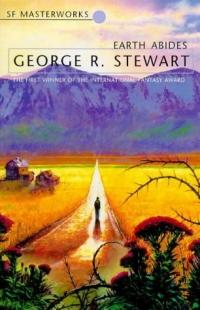 ion look.
ion look.
A 1983 Ballentine Books cover uses art similar to the Fawcett Crest cover. The Ballentine art has a more optimistic feel. The colors are brighter and the figure in the picture is walking down a road with light, perhaps the road to enlightenment.
The 1986 Fawcett cover (the edition we are currently using) returns to a darker style as seen in the original jacket cover. Even the wording on the cover is dark, "the world ravaged by plague and struggling for hope." Why is there a return to the darker cover? Does it have something to do the images of the Chernobyl Nuclear Power Plant which would be on everyone's mind in 1986?
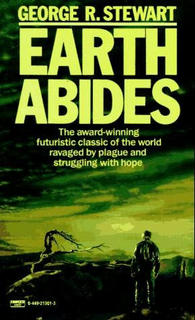 The 2004 cover on an audio version of Earth Abides by eBook Publisher: Paperback Digital, Inc., features the Golden Gate Bridge, a prominent symbol in the novel. Although still a dark cover, it more acurately depicts the book as Ish is always making reference to the structure.
The 2004 cover on an audio version of Earth Abides by eBook Publisher: Paperback Digital, Inc., features the Golden Gate Bridge, a prominent symbol in the novel. Although still a dark cover, it more acurately depicts the book as Ish is always making reference to the structure.
The covers on this post do not represent all of the cover adaptations of Earth Abides but they clearly illustrate how covers evolve over time. I do have one more I would like to share - it is a cover from the publisher, Minotauro and I feel it is one of the best I have seen. It features the Golden Gate Bridge, a car ( Ish spent a considerable amount of time traveling in a car in the first part of the book), and a sense that things are breaking down and falling apart. I like the brightness of the cover. It makes me feel there is hope and all is not lost. 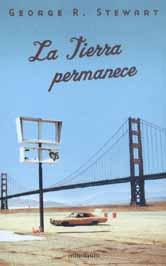
Heads up on my presentation
As for the presentation itself, I will be making three or four posts to cover the material I wish to discuss in class. At the end of the presentation I will be giving everyone a Points to Ponder sheet which I hope will kick off a great discussion.
Thank you for your patience. I will be making my first post soon.
Please note: My first post is now below this one.

